Fabrication of Silicon Nanowires by Metal-Assisted Chemical Etching Combined with Micro-Vibration
Abstract
:1. Introduction
2. Micro-Vibration Platform
3. Experimental
4. Results and Discussion
5. Conclusions
Author Contributions
Funding
Institutional Review Board Statement
Informed Consent Statement
Data Availability Statement
Conflicts of Interest
References
- Zou, Z.; Liang, J.; Zhang, X.; Ma, C.; Xu, P.; Yang, X.; Zeng, Z.; Sun, X.; Zhu, C.; Liang, D.; et al. Liquid-Metal-Assisted Growth of Vertical GaSe/MoS2 p–n Heterojunctions for Sensitive Self-Driven Photodetectors. ACS Nano 2021, 15, 10039–10047. [Google Scholar] [CrossRef] [PubMed]
- Giubertoni, D.; Paternoster, G.; Acerbi, F.; Borrise, X.; Cian, A.; Filippi, A.; Gola, A.; Guerrero, A.; Murano, F.P.; Romanato, F.; et al. Plasmonic Enhanced Photodetectors for Near Infra-Red Light Detection. In Proceedings of the International Convention on Information, Communication and Electronic Technology (MIPRO), Opatija, Croatia, 28 September–2 October 2020. [Google Scholar] [CrossRef]
- Kim, T.; Lim, D.; Son, J.; Cho, K.; Kim, S. Reconfiguration of operation modes in silicon nanowire field-effect transistors by electrostatic virtual doping. Nanotechnology 2022, 33, 415203. [Google Scholar] [CrossRef] [PubMed]
- Su, P.-C.; Chen, B.-H.; Lee, Y.-C.; Yang, Y.-S. Silicon Nanowire Field-Effect Transistor as Biosensing Platforms for Post-Translational Modification. Biosensors 2020, 10, 213. [Google Scholar] [CrossRef] [PubMed]
- Sreejith, K.; Sharma, A.K.; Basu, P.K.; Kottantharayil, A. A comprehensive investigation of the potential of metal assisted chemical etched (MACE) nano-textures over conventional micron-sized iso-textures for industrial silicon solar cell applications. Sol. Energy 2021, 230, 874–882. [Google Scholar] [CrossRef]
- Zhang, D.; Wang, L.; Jia, R.; Tao, K.; Jiang, S.; Ge, H.; Wang, B.; Gao, Z.; Li, X.; Li, M.; et al. Improving the performance of PERC silicon solar cells by optimizing the surface inverted pyramid structure on large-area mono-crystalline silicon wafers. Mater. Sci. Semicond. Process. 2021, 138, 106281. [Google Scholar] [CrossRef]
- Panigrahi, J.; Komarala, V.K. Progress on the intrinsic a-Si:H films for interface passivation of silicon heterojunction solar cells: A review. J. Non-Cryst. Solids 2021, 574, 121166. [Google Scholar] [CrossRef]
- Abidin, W.A.B.Z.; Nor, M.N.M.; Arshad, M.K.M.; Fathil, M.F.M.; Parmin, N.A.; Sisin, N.A.H.T.; Ibau, C.; Azlan, A.S. Femtomolar Dengue Virus Type-2 DNA Detection in Back-gated Silicon Nanowire Field-effect Transistor Biosensor. Curr. Nanosci. 2022, 18, 139–146. [Google Scholar] [CrossRef]
- Yusuf, M.; Herring, G.K.; Neustock, L.T.; Zaman, M.A.; Raghuram, U.; Narasimhan, V.K.; Chia, C.; Howe, R.T. Optimized Deep Reactive-Ion Etching of Nanostructured Black Silicon for High-Contrast Optical Alignment Marks. ACS Nano 2021, 4, 7047–7061. [Google Scholar] [CrossRef]
- Flassig, F.; Flaschmann, R.; Kainz, T.; Ernst, S.; Strohauer, S.; Schmid, C.; Zugliani, L.; Müller, K.; Finley, J.J. Automated, deep reactive ion etching free fiber coupling to nanophotonic devices. In Proceedings of the SPIE OPTO, San Francisco, CA, USA, 22–27 January 2022. [Google Scholar] [CrossRef]
- Saha, R.; Sikdar, S.; Chowdhury, B.N.; Karmakar, A.; Chattopadhyay, S. Catalyst-Modified Vapor–Liquid–Solid (VLS) Growth of Single Crystalline β-Gallium Oxide (Ga2O3) Thin Film on Si-Substrate. Superlattices Microstruct. 2019, 136, 106316. [Google Scholar] [CrossRef]
- Ngo, E.; Wang, W.; Bulkin, P.; Florea, I.; Foldyna, M.; Cabarrocas, P.R.I.; Maurice, J.-L. Liquid-assisted vapor–solid–solid silicon nanowire growth mechanism revealed by in situ TEM when using Cu–Sn bimetallic catalysts. J. Phys. Chem. C 2021, 125, 19773–19779. [Google Scholar] [CrossRef]
- Tatebayashi, J.; Mishina, M.; Nishiyama, N.; Timmerman, D.; Ichikawa, S.; Fujiwara, Y. Formation and optical characteristics of ZnO:Eu/ZnO nanowires grown by sputtering-assisted metalorganic chemical vapor deposition. Jpn. J. Appl. Phys. 2021, 60, SCCE05. [Google Scholar] [CrossRef]
- Matkivskyi, V.; Røyset, A.K.; Stokkan, G.; Tetlie, P.; Di Sabatino, M.; Tranell, G. Novel technique to study the wet chemical etching response of multi-crystalline silicon wafers. Mater. Sci. Eng. B 2023, 290, 116343. [Google Scholar] [CrossRef]
- Nur’aini, A.; Oh, I. Deep Etching of Silicon Based on Metal-Assisted Chemical Etching. ACS Omega 2022, 7, 16665–16669. [Google Scholar] [CrossRef] [PubMed]
- Tumashev, V.S.; Seleznev, V.A. A New Technique of Au Nanopattern Formation for Metal-Assisted Chemical Etching of Silicon. In Proceedings of the International Conference of Young Professionals in Electron Devices and Materials, Souzga, Russia, 30 June–4 July 2021; pp. 91–94. [Google Scholar] [CrossRef]
- Bollani, M.; Osmond, J.; Nicotra, G.; Spinella, C.; Narducci, D. Strain-induced generation of silicon nanopillars. Nanotechnology 2013, 24, 335302. [Google Scholar] [CrossRef] [PubMed]
- Chang, S.-W.; Chuang, V.P.; Boles, S.T.; Ross, C.A.; Thompson, C.V. Densely Packed Arrays of Ultra-High-Aspect-Ratio Silicon Nanowires Fabricated using Block-Copolymer Lithography and Metal-Assisted Etching. Adv. Funct. Mater. 2009, 19, 2495–2500. [Google Scholar] [CrossRef]
- Li, X.; Bohn, P.W. Metal-assisted chemical etching in HF/H2O2 produces porous silicon. Appl. Phys. Lett. 2000, 77, 2572–2574. [Google Scholar] [CrossRef]
- Arafat, M.Y.; Islam, M.A.; Bin Mahmood, A.W.; Abdullah, F.; Nur-E-Alam, M.; Kiong, T.S.; Amin, N. Fabrication of Black Silicon via Metal-Assisted Chemical Etching—A Review. Sustainability 2021, 13, 10766. [Google Scholar] [CrossRef]
- Van Minh, N.; Van Hieu, D.; Van Tuan, P.; Dung, N.D.; Hoang, C.M. Characteristics of silicon nano-pillars fabricated by nano-sphere lithography and metal assisted chemical etching. Mater. Sci. Semicond. Process. 2022, 142, 106483. [Google Scholar] [CrossRef]
- Kismann, M.; Riedl, T.; Lindner, J.K.N. Ordered arrays of Si nanopillars with alternating diameters fabricated by nanosphere lithography and metal-assisted chemical etching. Mater. Sci. Semicond. Process. 2021, 128, 105746. [Google Scholar] [CrossRef]
- Sandu, G.; Osses, J.A.; Luciano, M.; Caina, D.; Stopin, A.; Bonifazi, D.; Gohy, J.-F.; Silhanek, A.V.; Florea, I.; Bahri, M.; et al. Kinked Silicon Nanowires: Superstructures by Metal-Assisted Chemical Etching. Nano Lett. 2019, 19, 7681–7690. [Google Scholar] [CrossRef]
- Chunchuan, L.; Xingjian, J.; Steve, D.; Fengming, L. Recent advances in micro-vibration isolation. Mech. Syst. Signal Process. 2015, 56–57, 55–80. [Google Scholar]
- Lin, L.; Li, W.; Li, Y.; Ran, Z.; Yanpeng, W.; Jie, S.; Jun, Z. Micro-vibration suppression methods and key technologies for high-precision space optical instruments. Acta Astronaut. 2020, 180, 417–428. [Google Scholar]
- Stabile, A.; Wegrzyn, E.; Aglietti, G. Numerical and experimental validation of the breadboard model of a novel hexapod platform for high-performance micro-vibration mitigation. In Proceedings of the AIAA Scitech 2021 Forum, Online. 11–15 and 19–21 January 2021. [Google Scholar] [CrossRef]
- Jie, T.; Yang, Y.; Yinghui, L.; Dengqing, C. A 6-DOF micro-vibration isolation platform based on the quasi-zero-stiffness isolator. Proc. Inst. Mech. Eng. Part C J. Mech. Eng. Sci. 2021, 235, 6019–6035. [Google Scholar]
- Wu, J.; Tao, S.; Ma, X. New Algorithm Design of Micro-Vibration Isolation Platform’s Robust Controller. In Proceedings of the 2020 Asia-Pacific Conference on Image Processing, Electronics and Computers (IPEC), Dalian, China, 14–16 April 2020; pp. 140–143. [Google Scholar] [CrossRef]
- He, Z.; Shuai, H.; Zhenbang, X.; XiaoMing, W.; Chao, Q.; Jianfeng, Y.; Lei, Z. Iterative feedback control based on frequency response model for a six-degree-of-freedom micro-vibration platform. J. Vib. Control 2022, 28, 107754632199731. [Google Scholar]
- Xiaoxue, G.; Lin, L.; Yang, Y.; Li, W.; Lei, Z.; Miaomiao, W.; Yanpeng, W. Error analysis and calibration of micro-vibration test platform developed for advanced pointing instrument. Mech. Syst. Signal Process. 2022, 173, 109055. [Google Scholar]
- Li, L.; Liu, Y.; Zhao, X.; Lin, Z.; Wong, C.-P. Uniform vertical trench etching on silicon with high aspect ratio by metal-assisted chemical etching using nanoporous catalysts. ACS Appl. Mater. Interfaces 2014, 6, 575–584. [Google Scholar] [CrossRef] [PubMed]
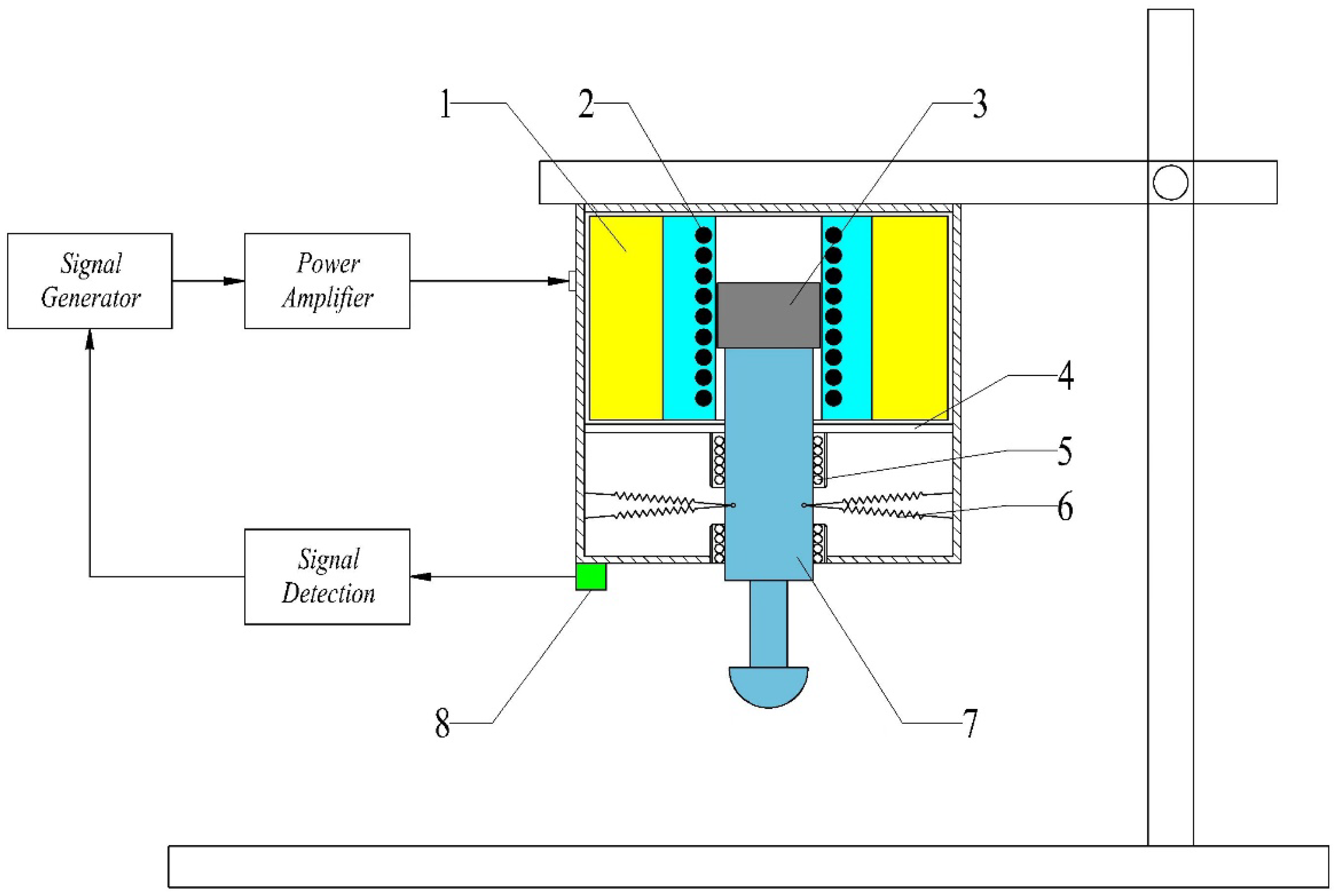
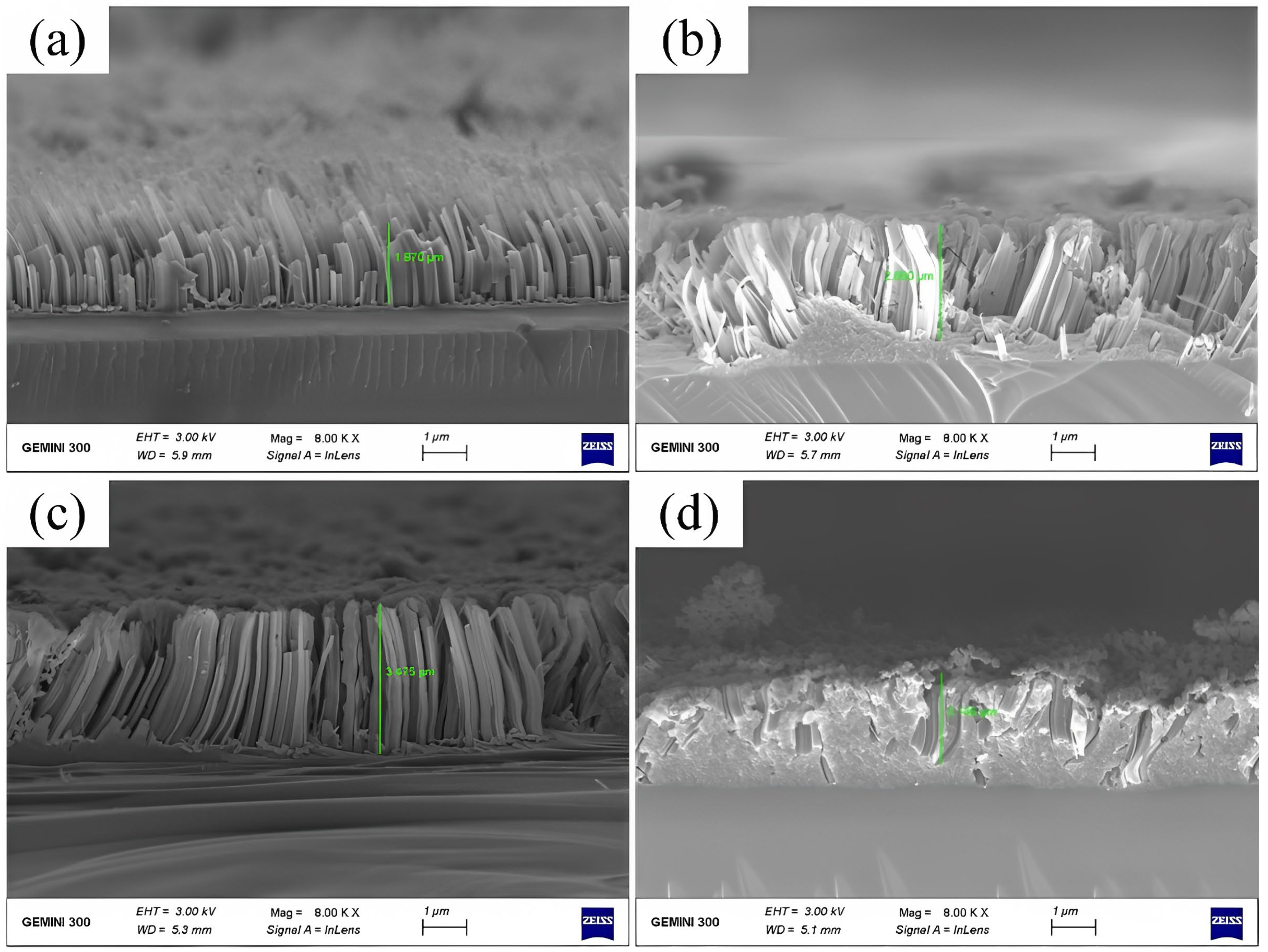
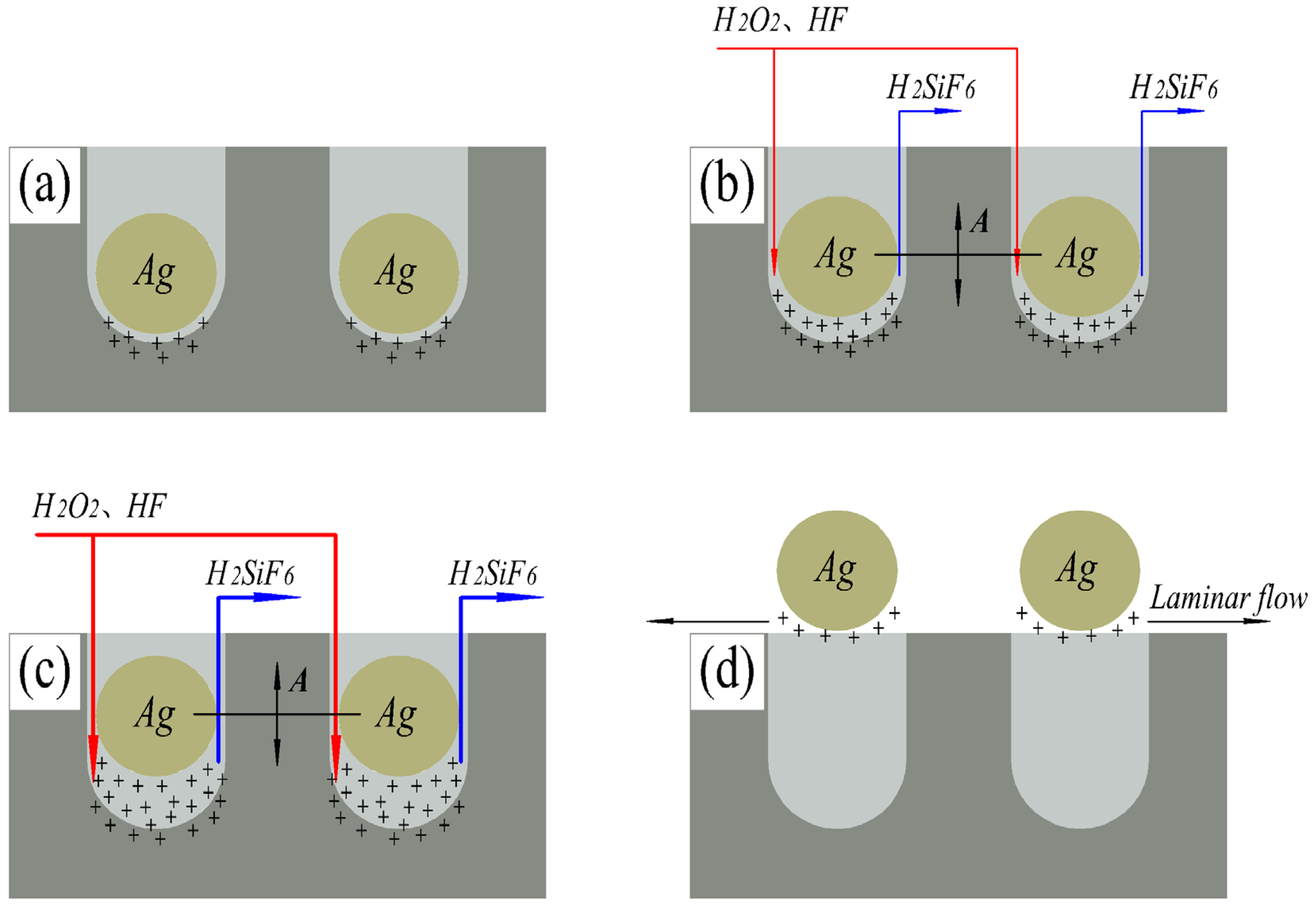

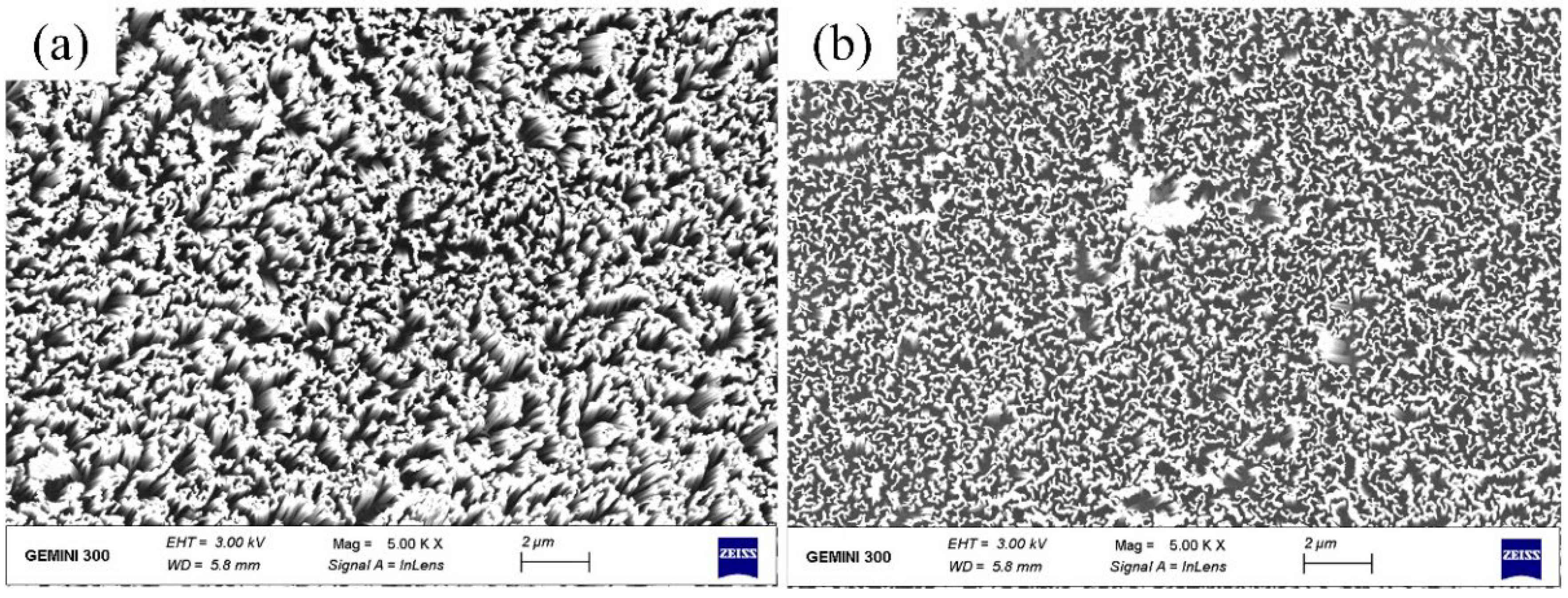
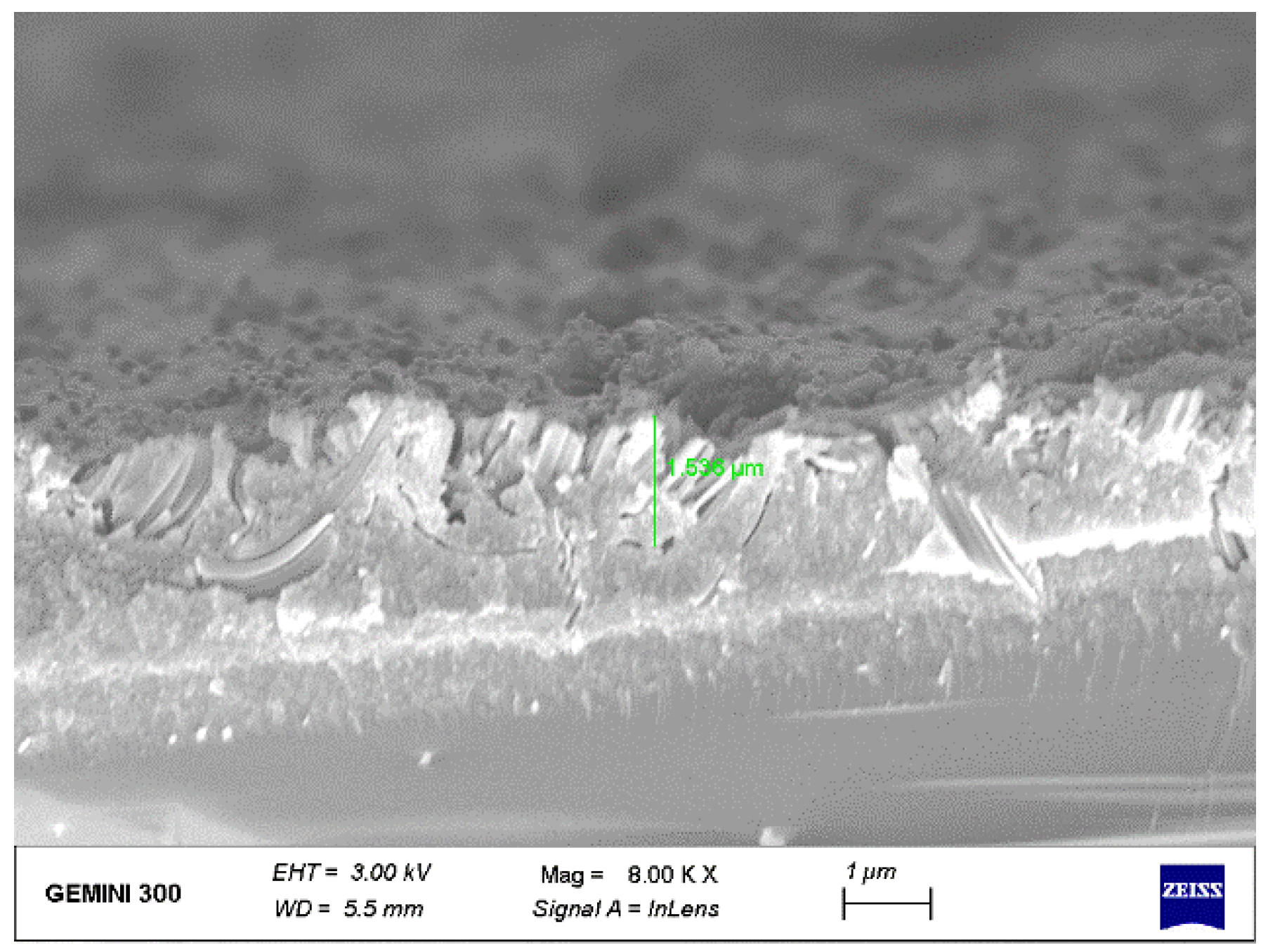
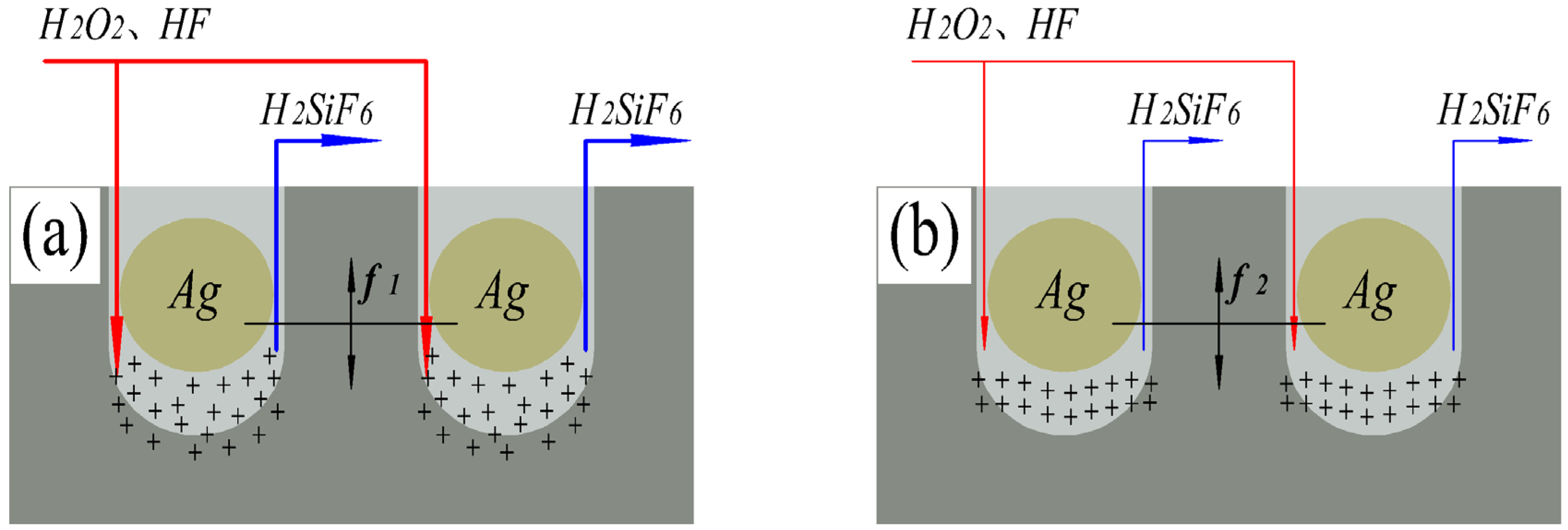
| Characteristic Parameter | FY2300-06M |
|---|---|
| Signal frequency range | 0~6 MHz |
| Frequency minimum resolution | 1 Hz |
| Output amplitude range (peak-to-peak) | 5 mVpp~20 Vpp |
| Amplitude resolution | 1 mV |
| Amplitude stability | ±5%/5 h |
| Characteristic Parameter | FPA1016 |
|---|---|
| Maximum output amplitude | 100 Vpp |
| Input signal amplitude range | 0~25 Vpp |
| Maximum output power | 30 W |
| HF (mol/L) | H2O2 (mol/L) | Amplitude (μm) | Frequency (Hz) | Etching Time (min) |
|---|---|---|---|---|
| 4.8 | 0.2 | / | / | 30 |
| 4.8 | 0.2 | 2 | 20 | 30 |
| 4.8 | 0.2 | 4 | 20 | 30 |
| 4.8 | 0.2 | 6 | 20 | 30 |
| 4.8 | 0.2 | 2 | 40 | 30 |
Disclaimer/Publisher’s Note: The statements, opinions and data contained in all publications are solely those of the individual author(s) and contributor(s) and not of MDPI and/or the editor(s). MDPI and/or the editor(s) disclaim responsibility for any injury to people or property resulting from any ideas, methods, instructions or products referred to in the content. |
© 2023 by the authors. Licensee MDPI, Basel, Switzerland. This article is an open access article distributed under the terms and conditions of the Creative Commons Attribution (CC BY) license (https://creativecommons.org/licenses/by/4.0/).
Share and Cite
Huang, W.; Wu, J.; Li, W.; Chen, G.; Chu, C.; Li, C.; Zhu, Y.; Yang, H.; Chao, Y. Fabrication of Silicon Nanowires by Metal-Assisted Chemical Etching Combined with Micro-Vibration. Materials 2023, 16, 5483. https://doi.org/10.3390/ma16155483
Huang W, Wu J, Li W, Chen G, Chu C, Li C, Zhu Y, Yang H, Chao Y. Fabrication of Silicon Nanowires by Metal-Assisted Chemical Etching Combined with Micro-Vibration. Materials. 2023; 16(15):5483. https://doi.org/10.3390/ma16155483
Chicago/Turabian StyleHuang, Weiye, Junyi Wu, Wenxin Li, Guojin Chen, Changyong Chu, Chao Li, Yucheng Zhu, Hui Yang, and Yan Chao. 2023. "Fabrication of Silicon Nanowires by Metal-Assisted Chemical Etching Combined with Micro-Vibration" Materials 16, no. 15: 5483. https://doi.org/10.3390/ma16155483





